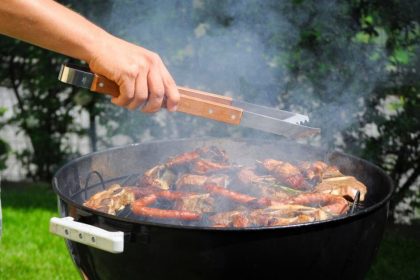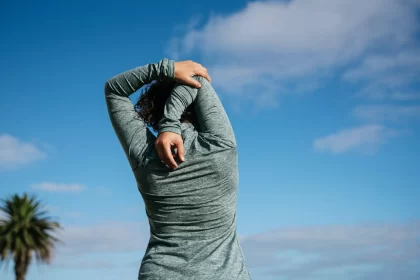On shopping excursions to gear kids up with a year’s worth of pencils, notebooks, and folders, many parents are opting to pack them all in an armored backpack.
By Tracy Collins Ortlieb
Michelle Marino was shopping for school supplies for her high-school-sophomore son earlier this summer when she made an impulse purchase: a Guard Dog Security ProShield backpack. Labeled “bullet-resistant” and touting “protection in session,” the backpack appealed to the San Marino, California, mother in the wake of multiple recent mass shootings.
“It wasn’t something I had thought about purchasing before I saw it, and it might be a sad statement about how our children have to live today, but I felt like I couldn’t afford not to buy one for my son’s safety,” Marino said, noting her husband later also purchased one for himself.
Featuring bulletproof panels designed to withstand multiple rounds from a handgun, the Guard Dog models are but one brand in a growing field of bullet-resistant products for children. This year, for the first time, big-box retailers including Office Depot and Office Max have included the backpacks among their back-to-school offerings. In addition, online retailers are marketing bulletproof jackets, seat cushions and child-sized hoodies—products that tap into a parent’s worst fears, and which experts say may not even be effective.
A Summer of Shootings
Late summer back-to-school shopping coincided with a wave of mass shootings across the U.S., notably at the Gilroy Garlic Festival in California, a Walmart store in El Paso, Texas, and downtown Dayton, Ohio.
According to Guard Dog CEO Yasir Sheikh, such tragedies increase interest in the company’s bulletproof backpacks. Following the 2018 mass shooting at Marjory Stoneman Douglas High School in Parkland, Florida, Sheikh says the company couldn’t keep up with consumer demand.
“After the Parkland incident, we sold out six months worth of backpacks in a few days,” Sheikh told Fox 35. “So now, of course, we’ve stocked accordingly, and we’re prepared for anything, whether it’s a spike in sales or back to school.”
Sheikh described the backpacks as lightweight and “a very tightly woven fabric, similar to what people might think of as Kevlar.”
“I would absolutely buy one if I had a high school student who wore their backpack all day or something similar,” said Jennifer Magid Schiller, a mom in Milton, Connecticut, with two children aged 7 and 19 months. “I’m contemplating buying one anyway to use with my family as the diaper bag when attending large events.
“It’s sad this is where we are at,” Schiller continued, “but considering government is doing nothing to protect Americans and likely won’t be anytime soon, and since I am anti-gun and will never be carrying my own, I feel it’s not a bad idea to own a backpack just in case.”
Questionable Effectiveness
Like most other bulletproof backpacks for kids, the Guard Dog models are advertised as meeting “Ballistic Level IIIA” standards, meaning they can withstand bullets from handguns and revolvers. Such certifications, however, fail to guard against military-style firearms such as the ones used in El Paso and Dayton.
According to the National Institute of Justice (NIJ)—the research, development, and evaluation agency of the Department of Justice—the only ballistic-resistant product that it certifies is law-enforcement body armor that meets the requirements of NIJ’s Compliance Testing Program.
While ballistic-resistant products are tested independently by the companies selling them, the institute “has never tested nor certified ballistic items, such as backpacks, blankets, or briefcases,” said Kelly Laco, a spokeswoman for the Justice Department, in a statement. “Marketing that claims NIJ testing or certification for such products is false.”
Such caveats are unworrying to James Clark, an Oldsmar, Florida father of one. A combat veteran of the US Army 10th Mountain Division, Clark has been placing a bulletproof backpack insert into the pack of his son Finn, now 10, since 1st grade.
Noting that the typical backpack already carries books, notebooks, and a tablet, Clark notes that “in terms of ballistic armor, you already have the fundamental formula for protection: layers. If you place level IIIA body armor on the terminal end of those layers, at a minimum a rifle round would be less lethal.
“While the chances of needing it are extraordinarily slim,” Clark says, “it’s a cheap insurance policy that he can carry for life.”
Exploiting fear for profit
Academics who study mass shootings say there is little, if any, proof that ballistic-armor products make children safer. Instead, they say, schools and lawmakers would be better served by banning assault-style weapons and high-capacity magazines as an effective means as preventing gun violence.
“The backpacks are an unfortunate trend, a case of exploiting fear for corporate profit,” says Matthew J. Mayer, a professor at Rutgers University whose research focuses on school violence prevention. Mayer says the numbers speak for themselves: given the one-in-a-million odds a child will be a victim of a school shooting, the chance that a child would have such a backpack handy at precisely the right moment—and also calibrate the shooter’s position, a bullet’s trajectory and proper backpack positioning—is “ludicrous.”
“This is a quick fix that takes away focus from more important things, like making schools a healthier and safer climate, where kids trust adults and communicate if there’s a threat, and fostering connections with families and the community,” he says. Mayer notes he is heartened by signs that legislators nationwide are crafting “red flag laws” that enable police to temporarily take guns from someone considered an imminent risk to others, and points to a recent study showing that tightened state gun laws have been associated with a (more than) 35% lower rate of firearm-related mortality, even after adjustment for socioeconomic factors and gun ownership.
“I respect the rights of people when it comes to the Second Amendment,” Mayer says, “but there’s also an argument for the greater good. We’ve seen the devastation, and it’s time everyone should ask, ‘Do we want to curtail some rights in the greater public interest?'”
For the time being, demand for such products continues to grow. Analysts currently estimate the market for bulletproof consumer gear to be in the tens of millions of dollars, while the market for security equipment and service in the education sector is expected to reach $2.8 billion by 2021.
Amy Stewart, a mom in Ashland, Oregon, says she is “disgusted” by the concept of ballistic-proof gear for children, and that her 8th and 3rd graders will be starting this school this fall with a traditional backpack.
“I have zero judgement for parents because we are all just trying to keep our kids safe, I just can’t believe we’re at this point,” Stewart says. “These backpacks seem to me to be the purest example of our failure as adults, politicians, society. Instead of tackling the problem of mass shootings by addressing mental health, access to guns, compassion for others, et cetera, we’re literally putting the burden of protecting themselves on our children’s backs.”
By Tracy Collins Ortlieb
Published in Parents




